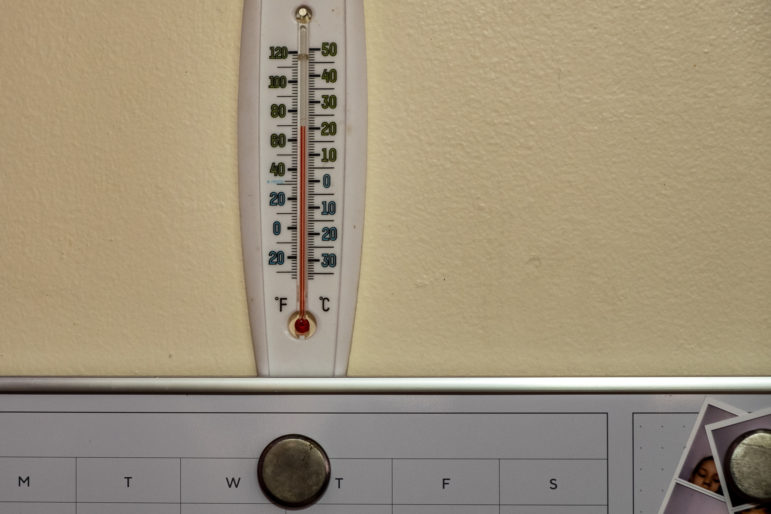
While Mayor Bill de Blasio has launched one of most ambitious housing plans in the city’s history—at least in terms of scale—housing policy is also the arena in which he has been most vulnerable to criticism. As City Limits reported before the primary, several of De Blasio’s opponents on the left argue that the mayor’s housing plan does not create enough units for the lowest income families and that his neighborhood rezonings will exacerbate overinvestment and displacement.
De Blasio’s Republican challenger in the general election, Assemblymember Nicole Malliotakis, has in fact made some of the same critiques as the left—calling for non-profit construction on public land and more permanent housing instead of more homeless shelters, and shaming the mayor for what she describes as his ties to developers and landlords. But Malliotakis also brings some traditional conservative lines of thinking to the matter, including an emphasis on cutting property owners’ taxes, and policy ideas that rest on the assumption that some homeless people are there to game the system.
Malliotakis’s policy plan on homelessness, Helping Our People Excel (H.O.P.E.), has already been subject to media criticism. She’s said she’ll give incentives to encourage the “one fifth” of NYCHA residents she says live in under-occupied apartments to downsize to smaller apartments, but according to NYCHA, only 11,000, or 6 percent, of NYCHA apartments are under-occupied, and there are only about 400 vacant NYCHA one-bedrooms and studios throughout the city. The De Blasio administration has already tried an incentive program to downsize residents, but found many residents did not want to leave their communities, a NYCHA spokesperson said.
Other parts of her plan have been billed as redundant of existing initiatives, and some will strike progressives as punitive. Many of her public assistance programs would be attached to job training or work requirements. She also wants to narrow the criteria for who can be permitted in a shelter, requiring that New Yorkers seeking shelter “have no other housing option such as family, whether in New York or out of state” and “have a clear path for community re-entry through education, job training and mental health assistance if necessary.” The Coalition for the Homeless has dismissed her plan as “a mish-mash of recycled plans and trial balloons accompanied by an imperious lifestyle lecture,” according to the Daily News. Picture the Homeless, which has objected to the de Blasio administration’s removal of homeless encampments, is discouraged by her promises to do the same—though likes that her plan mentions creating intake centers for shelters, as they’d like to see more than the existing ones throughout the city.
But there are ways in which Malliotakis has echoed homeless advocates’ top priority: more permanent housing for the homeless. She said at a press conference that instead of 90 shelters, the city would be better off building 90 apartment buildings on government land, though she couldn’t share specific details and admitted construction would take five to 10 years. She’s also talked about working with nonprofits to build housing for seniors, veterans, and low-income New Yorkers, as well as using land seized for tax delinquency for the construction of affordable housing, according to SiLive.com.
Still, many advocates and media pundits would like more specifics. A thorough report by the Village Voice’s Ross Barkan found that Malliotakis has made some powerful critiques of de Blasio, but lacked “any nuanced alternative to de Blasio’s housing platform.”
This week City Limits sent the candidate a set of questions to give her a chance to elaborate. Here are her answers to our questions, and our analysis.
Q: You’ve blamed rising property taxes and water bills as one cause of the affordability crisis. What do you think of the argument that the affordability crisis is primarily the result of a mismatch between the supply and demand of housing?
A: Home owners and building owners have suffered with rising property taxes and increased water rates yet Mayor de Blasio has only made the problem worse by increasing the property tax levy by 28 percent and water bills by double digits. If you are a homeowner, you are paying this directly. If you are a renter, it is most likely being passed on to you. Also, supply and demand does matter which is why there needs to be more of an urgency in building senior housing, veterans housing and additional affordable housing, not just preserving existing units which is mostly what Mayor de Blasio has done.
It’s true that revenue from property taxes has increased from FY 2014 to FY 2018 by 28 percent. Revenue has gone up, however, because property values are rising. It was Bloomberg, not de Blasio, who hiked the rate of the tax significantly; under De Blasio, tax rates for residential buildings have increased only marginally. Bloomberg also approved double-digit percent increases in the water rate; de Blasio has increased the water rate by 5.6 percent, 3.4 percent and 3 percent respectively. That’s not to say that rising water charges and property taxes are not a huge burden for homeowners. As City Limits reported this week, no one denies that the city needs to revamp its property tax system, but not everyone agrees that an across-the-board cap, a measure Malliotakis has supported while in the Assembly, is the best solution. In sum, the Assemblymember is right that property taxes have become a hardship for many owners—and she’d be correct to point out that Blasio has not rushed to correct it—but coming up with a solution will be harder than it sounds.
As for the matter of supply: Both De Blasio and Malliotakis believe that to address the affordability crisis, you need more housing, and it’s difficult to say at this point which one of them will be more pro-development. On the one hand, Malliotakis has previously criticized the mayor’s mandatory inclusionary housing policy for stifling development, saying that requiring 30 percent affordable housing is too much. On the other hand, she’s critical of the mayor’s rezoning plans, as she elaborates below.
Q: De Blasio is aiming to spur the construction of 80,000 units of income-targeted housing over ten years, and you said on Facebook Live that you want to build non-profit housing for seniors, veterans, and low-income people. Does 80,000 units sound like the right target to you?
While New York City struggles with the worst homeless crisis since the great depression, NYCHA continues to evict tenants and keep apartments off the rent rolls. As mayor I will focus my attention on assisting those who live in public housing to remain there and to swiftly repair apartments so they can be reintroduced to the market. Additional housing units will be developed as well. There needs to be more of an urgency in building senior housing, veterans housing and additional affordable housing, not just preserving existing units which is mostly what Mayor de Blasio has done.
According to NYCHA, only about one percent of NYCHA apartments are vacant. Malliotakis’ concern, however, echoes a 2015 report by Comptroller Scott Stringer that found some NYCHA vacancies lingered unoccupied for years and were improperly monitored. In response, NYCHA promised to implement reforms, though argued that the greatest impediment to filling vacancies was a lack of capital repair funds. We’ll explore later this month whether de Blasio, who has amped up investment in NYCHA, is doing all he can, and if Malliotakis could do any better.
As for that 80,000 target, Malliotakis eschews a number, but critiques de Blasio for focusing too much of his plan on housing preservation. This, of course, raises additional questions: If Malliotakis placed a greater focus on building than preservation, would that be a good thing for the city? And would she aim for more than 80,000 units of affordable housing? Perhaps it’s smart that she’s not pinning herself to a number, given the way some feel De Blasio’s target has prevented him from responding more nimbly.
Do you believe the mayor is focusing too much on working with for-profit developers instead of non-profit developers to build affordable housing?
As mayor I will seek out entities with expertise in large-scale housing management and development to ensure that public funds are used wisely. Currently, the mayor is selling off public land to his contributors as is the case with the Holmes Towers in Manhattan. Children are going to lose their playground so that a developer can construct a 47-story, mixed-rate building. That developer happened to have bundled $40,000 for Mayor de Blasio’s campaign. Unfortunately, we are seeing multiple incidents of pay to play with this administration including the lifting of restrictive deeds on Rivington House healthcare facility on the Lower East Side and the mayor’s support for the sale of Long Island College Hospital. Both properties will be turned into luxury condos and both were lobbied for by James Capalino who bundled $90,000 for Mayor de Blasio’s campaigns.
Malliotakis has mentioned the nonprofit development sector on the campaign trail, but in her answer she avoids detailing her position in the debate about preferences for nonprofits, instead shifting to a critique of de Blasio’s relationships with developers. While of course de Blasio was found innocent of any illegal behavior, she’s right that some of his donors have also been beneficiaries of his land use policies…though the developer at Holmes Towers, we add out of fairness, does plan to replace the playground and provide a recreation center, according to a city press release. And NYCHA isn’t selling the land, but providing a long-term ground lease to the developer.
What kind of income levels would your affordable housing seek to target? (The mayor’s plan aims to dedicate 25 percent of the 200,000 units built or preserved to families making less than 50 percent AMI, 58 percent of the units for families making between 50 and 80 percent AMI, and 22 percent of units from families making between 80 and 165 percent AMI).
I think the incomes need to be adjusted. I met a NYC school cafeteria worker in the Bronx who said she earned around $35,000 and made too much to qualify for affordable housing.
She’s avoiding a full answer, but seems to imply that de Blasio’s housing plan is not benefiting the middle class. Her anecdote is misleading: a single person who by themselves earns $35,000 falls in the 60 percent Area Median Income (AMI) bracket, which is the income bracket targeted by the majority of the units in de Blasio’s housing plan. A family of three that earns $35, 000 would be more likely to complain not that they made too much, but rather than they made too little, to qualify for the bulk of units.
What do you think of the mayor’s neighborhood rezoning plans, as passed in East New York and Far Rockaway and proposed in East Harlem, Jerome Avenue, Bay Street, Inwood, and elsewhere?
The Mayor offers a one size fits all, cookie-cutter approach to governing without taking into consideration that different neighborhoods have different needs. What works in Manhattan may not work on Staten Island and what works in Brooklyn may not work in Queens or the Bronx. Some neighborhoods may not yet have adequate transportation, infrastructure or school capacity to handle such development. Not every neighborhood can sustain vertical living. As usual, the mayor fails because he paints everything with a broad brush stroke because he doesn’t take the time to learn the needs or desires of communities. This is why I will have town halls at the BEGINNING of my term, not at the end as he is having.
On the one hand, there are certainly many critics who think Blasio is delivering a predetermined solution—additional density—to communities throughout the city, rather than sufficiently listening to what those communities need. On the other hand, we might also be seeing rezonings take place a lot faster (as some in the real estate industry would like) if the rezonings simply sliced with a cookie-cutter blade. You have to at least give it to the De Blasio administration that each rezoning has been paired with a Commercial District Needs Assessment study to get a sense of local commercial needs, and that under the new rezoning in Far Rockaway, new buildings will be generally shorter than those proposed for other rezoning areas, in recognition of Far Rockaway’s existing suburban character (though for sure, critics would have liked to see even shorter buildings).
You’ve called for more supportive housing. What do you think of the mayor’s plan for 15,000 units of supportive housing within 10 years? Are you committing to more than that?
We are in desperate need of housing for individuals with severe mental illness who are now either living on the street or in Riker’s Island. One way to achieve that would be to utilize empty hospital rooms throughout the Health and Hospital system. Retrofitting unused wings of our City hospitals to become transitional supportive housing units will allow us to get people the help they need while preserving jobs. We need a mayor who can actually get along with Governor Cuomo enough to create a New York/ New York IV agreement for supportive housing because the previous three under prior administrations were successful and cost-effective.
Malliotakis has repeatedly stressed that she would have a better partnership with the governor than the mayor, and it’s hard to imagine Cuomo and de Blasio’s relationship getting much worse. On the other hand, the Coalition for the Homeless has praised both the governor and the mayor for reaching separate supportive housing agreements, and gave de Blasio an “A” for supportive housing in its 2017 report card.
Why did you vote against two Assembly bills that would have strengthened rent regulation laws to protect tenants— 07526, in 2015, and 2674 in 2011?
These were one house bills that were poorly drafted and never went anywhere. I voted for the rent regulations that [were] signed by Governor Cuomo and became law.
Somewhat a cop-out. These bills did pass in the Democratic-controlled State Assembly. They went nowhere because the Republican Senate wouldn’t adopt them. Previously, Malliotakis told Crain’s she supports rent regulation but that “it has to be reasonable. We see a constant double-digit rise in our water bills. And then [de Blasio] wants to maintain rents. You will see fewer people investing in their buildings.”
Under the de Blasio administration there have been a lot of new initiatives launched to combat tenant harassment, and tenant advocates are still pushing for additional measures, including the creation of a citywide Certificate of No Harassment program that would put the onus on landlords that seek to redevelop a building to prove they had not harassed tenants. Do you support De Blasio’s efforts to crack down on tenant harassment and would you be open to exploring further measures such as the certificate of no harassment program?
No one should ever be harassed under any circumstances, especially with regard to the roof over your head. However, I do not believe the requirements placed on landlords should be overly burdensome, many of whom rely on rent as their only source of income. Unfortunately, both bad landlords and bad tenants exist, but government needs to be sensible in our approach to ensure that the rights of both sides are appropriately protected.
Interpret as you see fit.







